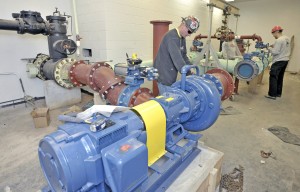
David Sclamo, center, of RH White Construction of Auburn, attaches a series of large diameter pipes that will flow water from the Granville Reservoir into a new 37,000-watt water turbine generator, foreground, at the Westfield Waterworks facility located on Reservoir Road in Southwick yesterday. The new water turbine generator is expected to help power the facility and should be on line by June. A conventional back-up generator is also located outside the building in case of an emergency. (Photo by Frederick Gore)
WESTFIELD – The Water Resource Department’s project to replace a transmission line and to upgrade the city’s water treatment plant should be completed next month.
The department has relied on the city’s well system to provide drinking water to residents while the Granville Reservoir was taken off line for two major projects.
One project has been the replacement of the raw water transmission line that carries water from Granville Reservoir to the treatment plant in Southwick. That project, which will cost just under $3 million, includes upgrading equipment at the treatment plant while it was off line.
Work crews are currently installing a new hydroelectric generation system in the treatment plant that will use the “head” of pressure created by water coming down the larger transmission line to provide most of the electrical power needed to operate the treatment plant.
“The raw transmission line work is done,” Water Resource Superintendent Dave Billips said this morning. “The refurbishment of the treatment plant is almost done. The plant is 25 years old and some of the equipment was outdated.”
The department used the time, more than a year now, since the plant was taken off line last spring to replace old equipment installed when the plant was constructed.
“We upgraded it with equipment that is more energy-efficient,” Billips said. “We did anything we could to make the plant more energy-efficient.”
Billips said that raw transmission line and plant should be returned to service by the end of May.
“We have to re-commission everything. It’s almost like starting up a new plant, testing the systems to ensure everything is working properly,” Billips said.
The other major project is repair damage to the Granville Reservoir dam that occurred during Hurricane Irene. The Water Commission voted to do both projects simultaneously to limit the time the city’s surface water resource would be off line.
Billips said that he anticipates that the dam repair work, which includes replacement of the spillway washout by Irene, will be completed this fall. That project also has a cost of about $3 million, but the city will receive a $1 million reimbursement from the Federal Emergency Management Agency because of the Irene-related damage.
“But we can start running the treatment plant before the dam repairs are completed, we just have to control the level of the reservoir so water isn’t going down the spillway,” Billips said.
Operating the treatment plant will take pressure off the wells as the city’s primary source of water.
“Some of the wells have been running almost continuously since we took the treatment plant off line, so we’ve been using a lot more electricity,” Billips said. “I’ve requested an appropriation from our reserve account of $150,000 to pay that electric bill.”
Billips said another cost avoidance will be that the hydroelectric generators currently being installed will mean that “most of the plant will be powered by electricity we recover with the turbines.”

